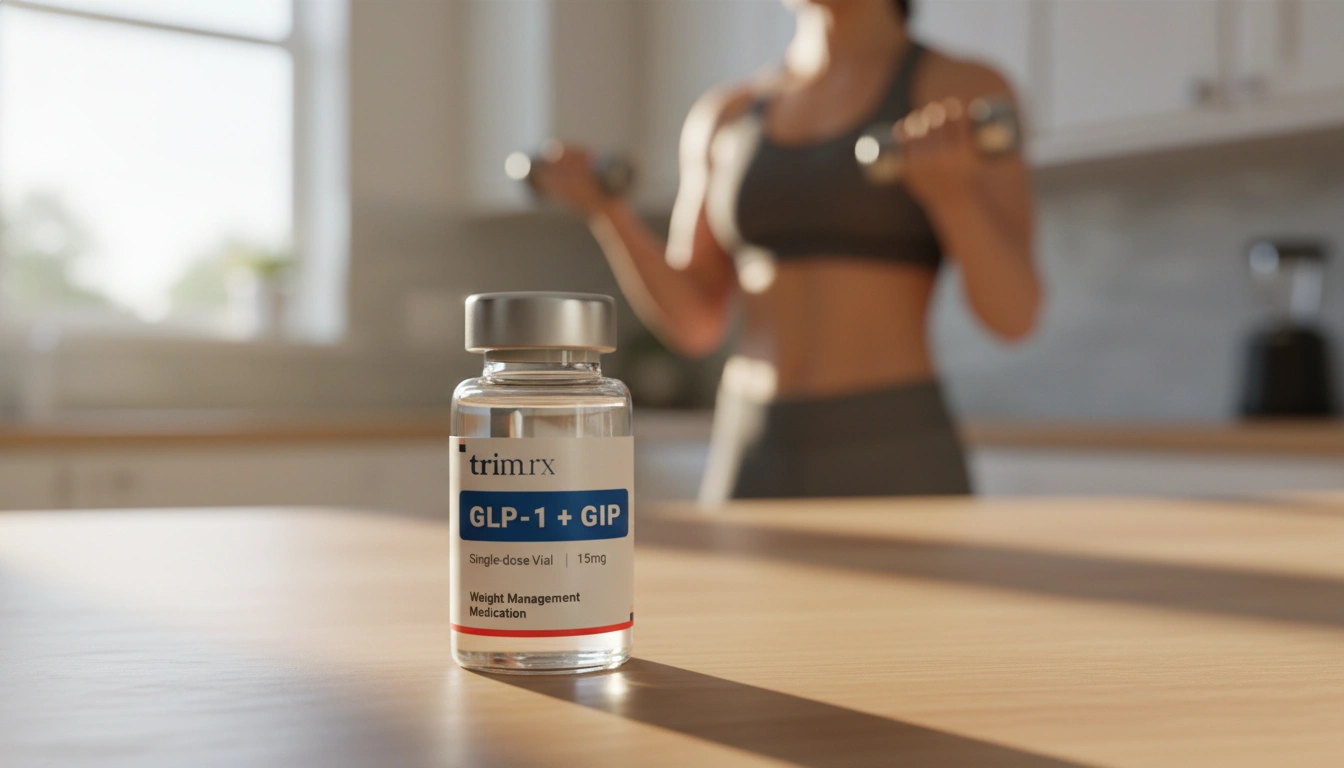How Often Do You Take GLP-1 Medications for Weight Loss?

Introduction
Did you know that nearly 42% of adults in the United States are classified as obese? This staggering statistic underscores the growing need for effective weight management solutions. GLP-1 medications have gained popularity not only for their ability to assist with weight loss but also for their role in managing blood sugar levels in individuals with type 2 diabetes. These medications mimic the effects of the GLP-1 hormone, which helps regulate appetite, slow gastric emptying, and promote insulin secretion.
At TrimRx, our mission is to empower individuals on their weight loss journeys by offering clinically proven, personalized weight loss solutions that prioritize safety, effectiveness, and individualized care. By merging cutting-edge telehealth innovations with effective weight loss strategies, we create a supportive environment where you can achieve sustainable results.
In this blog, we will cover:
- The different types of GLP-1 medications available
- How often you typically take GLP-1 medications
- The importance of following a personalized treatment plan
- Potential side effects and safety considerations
- The benefits of combining GLP-1 medications with a holistic weight loss approach
Together, we will explore how GLP-1 medications can be a valuable tool in your weight management arsenal, helping you to embrace healthier lifestyles and achieve your goals.
Every year, millions of individuals struggle with weight management, seeking effective solutions that align with their health goals. Among the various options available, GLP-1 (glucagon-like peptide-1) medications have emerged as a powerful ally in the fight against obesity and type 2 diabetes. But as we delve into the world of GLP-1 medications, a crucial question arises: How often do you take GLP-1?
Understanding the administration frequency of these medications is essential for optimizing their benefits and ensuring safety. In this blog post, we will explore the various GLP-1 medications, their mechanisms of action, recommended dosages, potential side effects, and how they work within personalized weight loss strategies. By the end of this article, you will have a comprehensive understanding of GLP-1 medications and how they can fit into your health journey.
What Are GLP-1 Medications?
GLP-1 medications are a class of drugs that mimic the action of the GLP-1 hormone, which is naturally produced in the gut. These medications primarily target two conditions: type 2 diabetes and obesity. The FDA has approved several GLP-1 medications for weight management, and they are often prescribed as part of a comprehensive treatment plan.
Types of GLP-1 Medications
There are several GLP-1 medications available on the market, each with unique dosing schedules and administration routes. Here are some of the most commonly prescribed GLP-1 medications:
- Semaglutide (Ozempic® and Wegovy®):
- Ozempic® is typically administered as a once-weekly injection for managing type 2 diabetes.
- Wegovy® is approved for chronic weight management and is also administered weekly.
- Liraglutide (Victoza® and Saxenda®):
- Victoza® is used for type 2 diabetes and is taken daily.
- Saxenda® is for weight management and is also taken daily, but at a higher dose than Victoza®.
- Dulaglutide (Trulicity®):
- Administered as a once-weekly injection, Trulicity® helps manage blood sugar levels and supports weight loss.
- Tirzepatide (Mounjaro®):
- Mounjaro® is a newer GLP-1 medication that is administered weekly and shows promising results for both diabetes management and weight loss.
- Exenatide (Byetta® and Bydureon®):
- Byetta® is taken twice daily, while Bydureon® is a once-weekly injection.
Mechanism of Action
GLP-1 medications mimic the effects of the GLP-1 hormone, which plays a vital role in the body by performing the following functions:
- Increases Insulin Secretion: GLP-1 medications stimulate the pancreas to release more insulin in response to meals.
- Decreases Glucagon Secretion: These medications reduce glucagon levels, which helps lower blood sugar levels.
- Slows Gastric Emptying: By slowing down the rate at which the stomach empties, GLP-1 medications help individuals feel fuller for longer, reducing overall food intake.
- Promotes Satiety: GLP-1 medications signal the brain to decrease hunger, making it easier to adhere to a reduced-calorie diet.
How Often Do You Take GLP-1 Medications?
The frequency of GLP-1 medication administration varies based on the specific medication prescribed and individual patient needs. Here’s a breakdown of the typical dosing schedules:
Weekly Dosing
- Ozempic®: Administered once a week, Ozempic® is a popular choice for individuals managing type 2 diabetes while also seeking weight loss. The dosing can start low and be gradually increased based on the individual’s response.
- Wegovy®: This medication is also taken once a week and is specifically designed for weight management, making it an excellent option for those looking to achieve and maintain weight loss.
- Trulicity® and Mounjaro®: Both of these medications are administered once a week, allowing for convenience and improved adherence.
Daily Dosing
- Victoza®: This medication is taken once daily and is effective at managing blood sugar levels while also supporting weight loss.
- Saxenda®: As a higher-dose formulation of liraglutide, Saxenda® is taken daily for weight management.
- Byetta®: This medication requires twice-daily injections, which may be less convenient for some individuals.
Determining Your Schedule
At TrimRx, we emphasize the importance of personalized treatment plans. The specific dosing schedule will depend on several factors, including your health history, weight loss goals, and any other medications you may be taking. To find out if you qualify for our prescription weight loss medications, we encourage you to take our free assessment quiz here.
The Importance of Following a Personalized Treatment Plan
Adhering to a personalized treatment plan is crucial for achieving the desired outcomes with GLP-1 medications. Each individual’s body responds differently to medications, making it imperative to work closely with healthcare providers to determine the most effective dosage and schedule.
Regular Monitoring
Regular follow-ups with your healthcare provider are essential for monitoring the effectiveness of the medication and making any necessary adjustments. This might involve:
- Blood Sugar Monitoring: If you’re using GLP-1 medications for diabetes management, it’s crucial to monitor your blood sugar levels regularly.
- Weight Tracking: Keeping a record of your weight can help assess the effectiveness of the medication and dietary changes.
- Side Effect Management: Monitoring for any side effects or adverse reactions will help you and your healthcare provider make adjustments as needed.
Comprehensive Support
At TrimRx, we believe that weight loss journeys require a holistic approach. Our services include:
- Unlimited Support: Patients can access ongoing support from healthcare professionals to address any questions or concerns.
- Nutrition and Lifestyle Guidance: Tailored nutritional plans and lifestyle modifications are essential for maximizing the benefits of GLP-1 medications.
- Lab Work: Regular lab work may be necessary to monitor health metrics, ensuring the safe administration of medications.
Potential Side Effects and Safety Considerations
While GLP-1 medications can offer substantial benefits, they may also come with side effects. Common side effects include:
- Nausea and Vomiting: These are often temporary and may decrease as the body adjusts to the medication.
- Diarrhea: Some individuals may experience gastrointestinal disturbances, particularly when starting the medication.
- Injection Site Reactions: Mild redness or irritation at the injection site can occur.
Serious Side Effects
While rare, some serious side effects may include:
- Pancreatitis: Symptoms include severe abdominal pain and should be reported to a healthcare provider immediately.
- Allergic Reactions: Signs of an allergic reaction can include rash, itching, or difficulty breathing, requiring immediate medical attention.
- Thyroid Tumors: There is a potential risk of medullary thyroid carcinoma (MTC), which has been observed in animal studies; however, the risk in humans is still being studied.
It’s crucial to discuss any concerns with your healthcare provider and to report any unusual symptoms promptly.
The Benefits of Combining GLP-1 Medications with a Holistic Approach
GLP-1 medications can be a powerful addition to a comprehensive weight management plan. However, they work best when combined with lifestyle changes, such as:
- Healthy Eating: A balanced diet rich in whole foods can enhance the effects of GLP-1 medications.
- Regular Exercise: Incorporating physical activity can further support weight loss efforts and improve overall health.
- Behavioral Modifications: Addressing emotional eating triggers and developing healthy habits are key components of sustainable weight loss.
Quick-Access Supplements
For those seeking additional support during their weight loss journey, we offer quick-access supplements like our GLP-1 Daily Support and Weight Loss Boost. These products can complement your GLP-1 regimen by providing essential nutrients and support for your weight loss goals. You can explore these options here and here.
Conclusion
As we’ve explored, the frequency of taking GLP-1 medications is highly individualized and depends on the specific medication prescribed and personal health needs. With the right approach and personalized care, GLP-1 medications can be an effective tool in achieving sustainable weight loss and managing type 2 diabetes.
At TrimRx, we are committed to providing safe, effective, and personalized weight loss solutions tailored to your unique journey. By combining GLP-1 medications with a comprehensive treatment plan that includes regular support, nutrition, and lifestyle modifications, you can take significant steps towards a healthier, happier life.
If you’re ready to take control of your weight loss journey, we invite you to take our free assessment quiz here and explore the personalized options available to you.
FAQ
What are GLP-1 medications?
GLP-1 medications are a class of drugs that mimic the actions of the GLP-1 hormone to regulate appetite and blood sugar levels. They are used to treat type 2 diabetes and support weight loss.
How often do you take GLP-1 medications?
The frequency varies by medication. Some, like Ozempic® and Wegovy®, are taken once weekly, while others, like Victoza® and Saxenda®, are taken daily.
What are the common side effects of GLP-1 medications?
Common side effects include nausea, vomiting, diarrhea, and injection site reactions. Most side effects tend to decrease over time.
Can GLP-1 medications help with weight loss?
Yes, GLP-1 medications can promote weight loss by reducing appetite, increasing satiety, and slowing gastric emptying.
How can I determine if GLP-1 medications are right for me?
A personalized assessment with a healthcare provider can help determine eligibility and create a tailored treatment plan that meets your specific needs.

Transforming Lives, One Step at a Time
Keep reading
7 Tips for Sticking to GLP-1 Injection Schedules
Seven practical strategies to keep weekly GLP‑1 injections on schedule—pick a routine day, set reminders, manage side effects, rotate sites, and avoid missed doses.
Custom GLP-1 Dosing for Kidney Disease
Personalized GLP-1 dosing for CKD patients with monitoring, dehydration and hypoglycemia risk mitigation, and guidance across all kidney disease stages.
Semaglutide vs Tirzepatide: Approved Uses
Two leading diabetes and weight-loss drugs differ in FDA-approved benefits — one adds heart, kidney and liver protection; the other treats obstructive sleep apnea.



